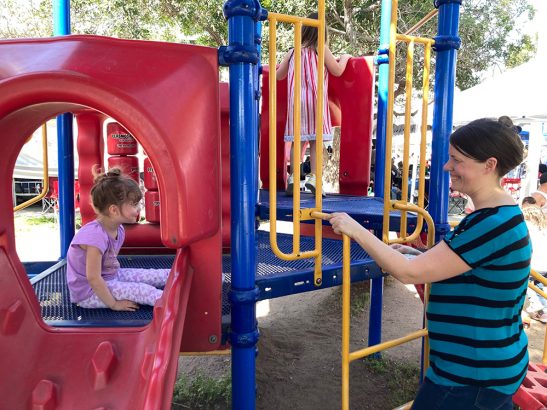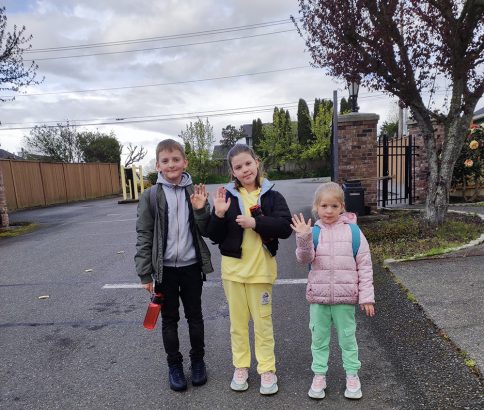Ukrainian Refugees Fan Out Across U.S., Enroll Kids in Local Schools While Others Wait at Border
By Jo Napolitano | April 28, 2022
Just over the zigzag pathway of the Tijuana border crossing, a mile or so from the taco and churros stands that feed locals and tourists alike, past the indigenous women sitting on the sun-scorched sidewalk and begging for change with infants at their breasts, rests a pop-up encampment for Ukrainian and Russian refugees fleeing an invasion they could neither endure nor support.
From February until just this week, Mexico has been their second-to-last stop in a weeks-long journey; Tijuana a two or three-day respite on the way to something better, something safer, where their children can slowly work toward normalcy after their lives were upended by war.
These displaced families — a flight away from Washington state or Illinois or South Carolina — are fanning out across the country, staying with friends and relatives, applying for food stamps and Social Security cards and enrolling their children in school. While they are far further in their relocation than the Mexican, Central American and Haitian asylum seekers waiting years for that same opportunity, these newcomers still face many hurdles.
“Everything is so different here in the U.S.,” said Anastasiia Puzhalina, a Ukrainian refugee who arrived in the States in early April alongside her family. “We must learn so much. I hope we’ll get through this.”
More than 5.2 million people have fled Ukraine since the start of the invasion: another 7.7 million have left their homes but remain inside the country. More than 1,000 education facilities have been attacked — the figure likely includes an art school where 400 people were sheltered — according to the United Nations Office for the Coordination of Humanitarian Affairs.
The Russian invasion has been chaotic, surprisingly inept and unbearably brutal, often targeting civilians. Thousands have died — the exact number is a subject of debate and might not be known for years — with hundreds discovered in mass graves. Women and girls have been particularly vulnerable to sexual assault. All of which has forced families with means to make their way out.
The refugees who arrive in Tijuana enter the encampment with pained expressions, scrambling to corral both their children and their belongings, their anxiety evidenced in their sharp tones and lack of patience with the worn-out youngsters they tote. Once inside, their mood shifts. Handed a water bottle and ice cream by dozens of Ukrainian and Russian-speaking volunteers, many of whom flew down from the U.S. to assist, they are directed to a check-in desk where a smiling blonde woman assigns each individual, couple or family a number that will be called when it’s time to leave. Other aid workers will drive them to their next stop: often San Diego International Airport.
That’s exactly what Puzhalina was waiting for when she spoke to The 74 inside the site. She listened carefully to each number, eager for hers: 2567. Sitting under the partial shade of a palm tree, she said the family felt safe in the encampment, though they were told not to venture out into the city. Tijuana, population 1.3 million, saw 1,972 homicides in 2021. By comparison, there were 485 in New York City, more than six times its size.
The U.S. Department of State warns Americans to avoid the city, an essential corridor for narco-trafficking and human smuggling, because of crime and kidnapping. Puzhalina didn’t know this, but could see the poverty on her way to the site: When her family was riding through town in a taxi, they came upon a building covered in barbed wire.
“I thought it was a prison,” Puzhalina said. “They told me it was a school.”
The family didn’t stay in Mexico for long: Within days, they flew to Tacoma, Washington.

Anatoli Bassarskii, 37, of Chernivtsi in western Ukraine, hadn’t decided where he and his family would move: They planned on New York City but a volunteer inside the camp, a Russian transplant who lives in Washington state, suggested they move near him: He had a friend whose home was in need of repair. The family could rent the place cheap if they helped fix it, he said.
No matter where they settle, they intend to enroll their 10-year-old son Artur in school right away so he can learn English and have only a minimal disruption to his education. Bassarskii is concerned about the fifth-grader fitting in.
“With the language barrier and different cliques of kids, I’m worried about him being bullied,” he said through a translator.
Artur, handsome with bright blue eyes, had already found playmates upon his arrival to the camp in early April and hoped for the same in the States.
He believed his American school would be an improvement over what he had in Ukraine, with better and more up-to-date facilities. An athlete with aspirations of becoming a dentist, he wasn’t worried about assimilation. “I’m sure everyone will say hi to me,” he said, a Nike backpack slung across his shoulders. “Everyone will be my friend.”
His father hopes his son is right, because the family plans to stay in the country permanently.
“We want to live in America forever,” Bassarskii said.
Unite for Ukraine
Other asylum seekers have not been given the same priority. Fleeing the twin atrocities of gang violence and poverty in their own countries, Mexican, Central American and Haitian refugees have not been offered the expedited pathway laid out for the Ukrainians despite waiting at the border for years.
They have been held in place by a COVID-era policy called Title 42 which, enacted in March 2020, allowed the United States to refuse their entry because of health concerns. And their living conditions are atrocious: Their flimsy tents, flooded by heavy rains and blown away by high winds, sit unguarded and vulnerable in crime-infested places like Reynosa, across the border from McAllen, Texas, and far different from the clean and orderly Tijuana encampment.
Here, volunteer nurses check children and adults for signs of heat stroke and aid workers from local churches come through nearly every 15 minutes with donations of toys and food, including fresh fruit and vegetables and Eastern European staples.
Kids in clean clothes — either their own or taken from dozens of boxes of nearly new goods — play with Legos or visit a craft station where they make bracelets and necklaces with donated beads while the older children head for the basketball court or work out on the exercise equipment scattered throughout the park.
Immigrant advocates recognize the disparity and wish for similar treatment for all.
“I believe that everybody who has a legitimate claim and has a fear for their lives should be given the right to enter the U.S.,” Sister Norma Pimentel, executive director of Catholic Charities of the Rio Grande Valley in South Texas, told The 74. Her organization has served hundreds of thousands of people crossing over in recent years.
“Someone coming to the border asking for protection should get it,” said the revered 68-year-old Mexican-American nun, who has frequently spoken on the nation’s immigration policies. “It shouldn’t matter what country you are coming from.”

But that has not been the case. Last week, President Biden, who has already pledged to welcome 100,000 Ukrainian refugees, announced “Unite for Ukraine”, a streamlined immigration program that will allow those fleeing the country to arrive in the United States directly from Europe, bypassing Mexico. They must have been in Ukraine as of Feb. 11; have a sponsor who can financially support them — this can be in individual or organization — complete vaccinations and other public health requirements and pass background checks. The new policy went into effect Monday.
Most will receive two years of residence and authorization to work in the United States. Those who continue trying to enter the U.S. through Tijuana are subject to Title 42, but that might not last long. The restriction is set to be lifted May 23 although lawmakers from both parties worry the southern border isn’t ready for the influx: Tens of thousands of people are waiting for entry, including 9,000 in Reynosa alone, Pimentel said.
Adding to these concerns, the Supreme Court heard oral arguments this week on the Biden administration’s attempts to end the 2018 Migrant Protection Protocols, which require some asylum seekers to remain in Mexico for the duration of their U.S. immigration proceedings.
U.S. Customs and Border Protection has reported nearly 15,000 encounters with Ukrainian and Russian refugees since the start of the year. It logged more than 349,008 such incidents with asylum seekers from Mexico, El Salvador, Guatemala, Haiti and Honduras in that same time period.
One request: Peace
The children of these Ukrainian families are just starting to trickle into the nation’s schools: South Carolina, for example, has 101 more Ukrainian and 29 more Russian students today than it did around this same time last year with many enrolling in Spartanburg, Lancaster and Greenville counties.
South Carolina school districts that have called the state for assistance in admitting newcomers without transcripts have been reminded of their legal obligation to enroll these students quickly. They’re also advised to find proper translation services so they can communicate with their families. State officials say, too, newcomers are invited to participate in summer programs to help with language acquisition.
They know at least some of these students have experienced trauma on the way out of their home countries and believe schools, flush with cash because of the pandemic, are likely more equipped to help them than in years past.
And qualifying South Carolina school districts will see an increase in funding for all new immigrants, no matter their country of origin.
“We want them to feel valued … and welcomed for all of the expertise they bring to our communities,” said Susan Murphy, who serves multilingual learners at the state level.

Oksana Bevzenko, who arrived in Mexico from Kyiv with three of her children, ages 17, 14 and 4, planned to relocate to Spartanburg, South Carolina.
She spent an afternoon in early April trying to feed her daughter an orange as the child walked along the landing of a large red, blue and yellow piece of playground equipment near the center of the Tijuana encampment.
Asked what she wanted for her children in America, she had only one request: Peace.
She’s glad to have the youngest at her side. It’s her oldest she’s worried about. At 19, he was unable to leave the country, she said, and stayed behind to deliver food and other aid in Kyiv.
“We talk every day,” she said. “He tells me he’s OK.”
Diana Zhernovnikova, mother of four children, ages 7, 5, 3 and 1, held her baby in her arms as she sat in the shade of a large white tent, her next youngest sitting across from her in a small blue stroller. She and her husband, Alexandr, were on vacation in Spain when the war broke out. They’ve not returned to their hometown of Kyiv — and they’re not sure they ever will.
Too painful to look back, she’s only looking ahead. “We’re going to join relatives in Philadelphia,” she said. “We’ll enroll the kids in school right away.”
The family, as of April 22, had not yet reached their final destination. They’re currently staying with relatives in San Antonio but still plan to head to Pennsylvania. They have not enrolled the children in school because they are still in transition.
Hamburgers and chocolate milk
Anastasiia Puzhalina, who now lives in Tacoma, has already registered her children in school. Her 10-year-old son, Illia, had expressed worry about that transition, fearing he would be misunderstood because he does not speak English.
“I’m afraid someone will be unfriendly to me because I’m a refugee,” he said when interviewed back at the encampment. “I wish I could have at least one Ukrainian- or Russian-speaking kid in my class so I could feel comfortable. I want to make friends.”
His 6-year-old sister, Virsaviia, picking up her brother’s trepidation, said she wished her cousin could be in her class, but the child is a full year younger, her mother said.
The children started school April 21.

“They loved the first day,” their mother reported. “They remembered the names of their teachers, but didn’t remember some names of their new friends because they sound so different from our Ukrainian. They liked the lunch: burgers and chocolate milk. It sounds like a dream lunch for them. They take English classes most of the time. Everything is like in an American movie for them.”
It’s difficult to align those images with the terror the family experienced just weeks ago.
Food was running low and the local markets were empty in Puzhalina’s hometown of Slavutych, near the border of Belarus. She had stocked up on supplies at the start of the invasion — volunteers from nearby towns brought milk, potatoes, corn and wheat for bread making — but, eventually, her community lost both gas and electricity. The family was forced to cook all of its food at once, outdoors, on an open flame fueled by wood they gathered from a nearby forest — lest it rot.
They had no internet, no working cell phones, no way to see or hear the news of what was happening in Slavutych. Puzhalina’s village wasn’t under direct fire, but there was no safe way out: The surrounding region had already been bombarded, key bridges destroyed.
Puzhalina said she asked God to show her “silence in her heart” so she and her husband would know the exact moment to escape with their three children. So, she waited for that clarity, when she could no longer hear bombs dropping in the distance, when all she heard was silence. Just then, a neighbor knocked on her door to tell her some of the families in her community were preparing to leave. She believes God answered her prayers.
“In that moment, I packed our bags, and we left,” she said, pressing a closed fist against her chest.
The family made its way to Poland along dirt roads, praying as they passed several checkpoints in a caravan of between eight and 12 cars, each packed with people. The Puzhalinas’ tiny Chevrolet Aveo, crammed with two adults and three children, was ill-suited for the off-road journey. But they somehow made it out.
After two days of travel, they crossed into Poland on March 15. Puzhalina’s sister hosted them for a week before they moved on to Germany, where they stayed with another relative for nearly 14 days.
Eventually, Puzhalina’s brother-in-law helped the family buy tickets from Frankfurt to Amsterdam to Mexico City and, finally, Tijuana, where they arrived April 7.
There is only one way to describe their safe passage, she said: “It was a miracle.”
Lead Image: The Puzhalina family waits inside a Tijuana encampment for their chance to cross into America. From left to right: Illia, 10, Oleh, 32, Yeva, 9, Anastasiia, 33, Virsaviia, 6. (Jo Napolitano)
Get stories like these delivered straight to your inbox. Sign up for The 74 Newsletter

